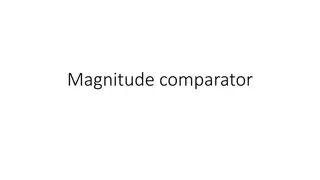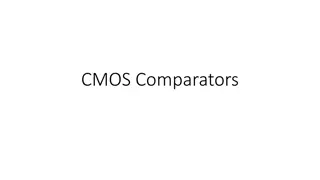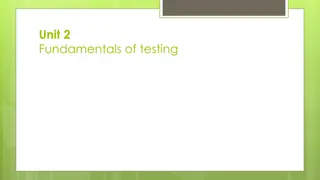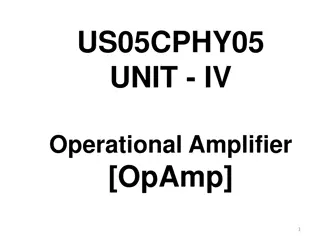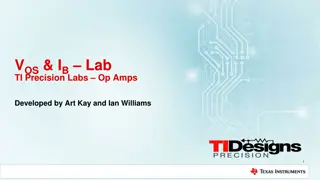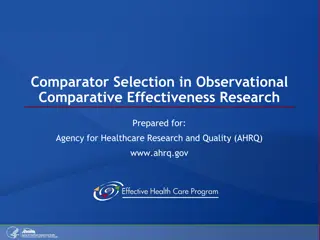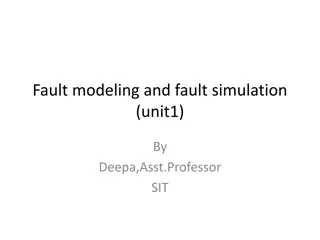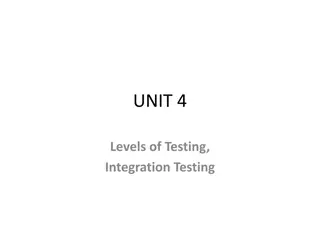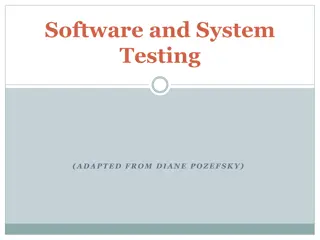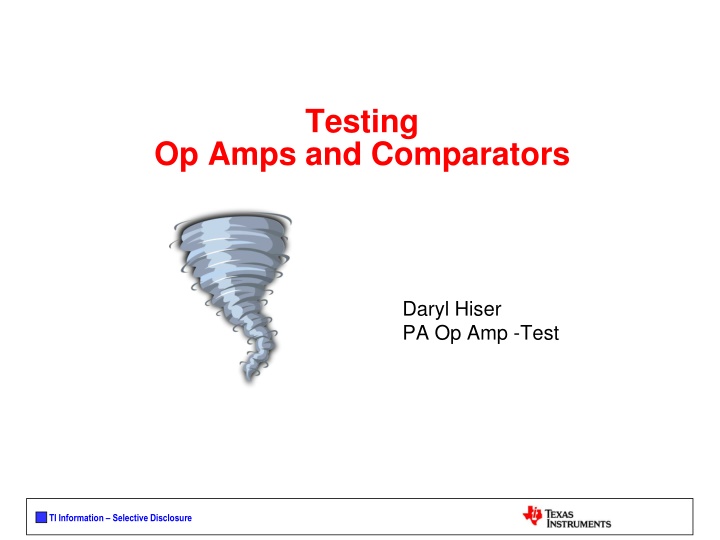
Testing Op Amps and Comparators Techniques by Daryl Hiser - TI Insights
Dive into the world of testing op amps and comparators with Daryl Hiser as he shares insights on techniques like pattern-based testing, op amp loops, and more. Beware of common errors and learn how to effectively test these components. Discover practical methods for measuring Vos and controlling op amps during tests.
Download Presentation

Please find below an Image/Link to download the presentation.
The content on the website is provided AS IS for your information and personal use only. It may not be sold, licensed, or shared on other websites without obtaining consent from the author. If you encounter any issues during the download, it is possible that the publisher has removed the file from their server.
You are allowed to download the files provided on this website for personal or commercial use, subject to the condition that they are used lawfully. All files are the property of their respective owners.
The content on the website is provided AS IS for your information and personal use only. It may not be sold, licensed, or shared on other websites without obtaining consent from the author.
E N D
Presentation Transcript
Testing Op Amps and Comparators Daryl Hiser PA Op Amp -Test TI Information Selective Disclosure
Op Amps, Comparators, and Pattern Based Testing oh my! TI Information Selective Disclosure
Outline Basics of testing Op Amps. The Loops The Tests Pattern Based Testing. Basics of testing comparators. Beware of flying monkeys! (common errors, issues, things to watch for) TI Information Selective Disclosure
Op Amp Loops If you can measure Vos well, most of the Op amp test battle is won! PSRR, CMRR, AOL, Drift are just looking for changes in Vos as some parameter is varied. We use test loops to facilitate measurement and control of op amps during test. The loop gives local gain of the offset measurement. This presentation will evaluate two useful loop methods: - False Summing Junction - Two Amp Loop TI Information Selective Disclosure
Eagle Op Amp HIB TI Information Selective Disclosure
Op Amp test loops (False Summing Junction) 101(Vos) + - +10V + - 100K 100K Loop Drive 100K 100 Vos - Vout DUT + i = Vos / 1K Vos 1K ~ -10V Offset Correction Factor = ACL + AFS Vo = -(Vi + Vos(O.C.F)) TI Information Selective Disclosure
Op Amp test loops (False Summing Junction) +10.302V 101mV + - +10V + - 100K 100K Loop Drive i3 = 97.99 A 101.01 A i2 = 98.99 A 102.01 A 100K - Vout + DUT + i1= 1 A 1K -9.698V -10.0V 1mV - ACL = 200K/1K + 1 = 201 ASJ = 100K/1K + 1 = 101 OCF = 302 Offset Correction Factor = ACL + ASJ Vo = -(Vi + Vos(O.C.F)) TI Information Selective Disclosure
Op Amp test loops (False Summing Junction) The worse the DUT s DC precision the more significant loop errors become. 101(Vos) 100K 100K Loop Drive 100K Pro s Simple - Vout DUT + Stable 1K Con s Small (4 tiny surface mount resistors and you can test everything but IB Feedback R is a Load Loop drive a function of DUT Vos. TI Information Selective Disclosure
Op Amp test loops (2 Amp Loop) Pro s Con s No Load Current More complex Requires Compensation!! Loop drive is independent from DUT Vos 100 Vos 10K 25pF Type 2 i = Vos / 100 Vout DUT 100 101 Vos Null Amp +10V Vos 10K Loop Drive 1nF Type 1 +10V TI Information Selective Disclosure
Bode plot for 2 Amp Loop (uncompensated) 100K 240 Vout 220 DUT 100 Null Amp 200 2K Loop Drive 180 160 Combined response Both Amps Closed loop Gain ACL (100K/100) +1 = 1001 or ~ 60dB 140 Gain dB 120 100 Null Amp 40db/decade closure! 80 ACL 60 DUT 40 20 0.01 0.1 1 10 100 1K 10K 100K 1M 10M Unstable !!!!! Frequency Hz TI Information Selective Disclosure
100K Type 2compensation 80pF Vout 240 DUT 100 Null Amp 220 2K 200 Loop Drive 180 160 Combined response Both amps 40db / decade 140 Gain dB 120 CF= 1 / (20KHz x 100K x 2 ) = 80pF 100 80 ACL 60 20db/decade closure! 40 20 Stable !!!!! 0.01 0.1 1 10 100 1K 10K 100K 1M 10M Frequency Hz TI Information Selective Disclosure
Type 2compensation range 240 220 200 180 160 140 Gain dB 120 Lowest pole frequency 100 Optimum compensation 80 ACL Highest pole frequency 60 40 20 0.01 0.1 1 10 100 1K 10K 100K 1M 10M Frequency Hz TI Information Selective Disclosure
Bode plot for Type 1 comp. 100K 240 Vout DUT 100 Null Amp 220 2K 200 Loop Drive 100pF 180 160 Closed loop Gain ACL (100K/100) +1 = 1001 or ~ 60dB 140 Gain dB 120 Combined response Both Amps 100 20db/decade closure! 80 ACL 60 DUT 40 Null Amp (integrator) 20 Stable !!!!! 0.01 0.1 1 10 100 1K 10K 100K 1M 10M Frequency Hz TI Information Selective Disclosure
Type 1 Compensation Range 240 220 200 180 160 140 Gain dB 120 Intersection of Combined response with Closed loop gain (ACL) 100 80 ACL 60 Null Amp(integrator) zero frequency 40 20 Optimum is intersection / 4 0.01 0.1 1 10 100 1K 10K 100K 1M 10M Frequency Hz TI Information Selective Disclosure
Optimizing compensation 10K 25pF Vout DUT 100 Null Amp 10K Loop Drive 1nF You can make bode plots to find the best compensation for either method. Or You can use TINA spice and evaluate through simulation Or TI Information Selective Disclosure
Rf Type II Amp1 Rin Amp2 Rc Loop Drive use the easy button. Type I Type 1 compensation Given Rf, Rin, Rc, BW1 Type II compensation Given Rf, Rin, BW1, BW2: TI Information Selective Disclosure
Op Amp testing basics Key Parameters Abbr. Continuity / Contact resistance Quiescent Current Input offset voltage Power Supply Rejection Common Mode Rejection Open Loop Gain Short circuit current Slew Rate Gain Bandwidth Input Bias current Cres IQ VOS PSRR CMRR AOL ISC SR GBW IB Noise Total Harmonic Distortion THD TI Information Selective Disclosure
Continuity ***1 current *** Continuity is measured by sourcing a small current (100uA typ.) through each IO pin through the ESD diodes to the positive supply, and then sinking current through the diodes connected between the IO pins and the negative supply. This verifies all ESD diodes are connected as well as all wire bonds intact and some contact to each pin. i1 = 100 A Vcc i1 = 100 A APU Vcc APU Vout Vout DUT APU DUT APU APU APU APU APU Vee Vee APU APU 18 TI Information Selective Disclosure
Contact Resistance ***2 currents*** CRES is measured between each supply and the output using 10mA and 15mA currents to get past the diode I/V knee. It is a bulk resistance includes 2 contact resistances and the internal diode resistance. Junction Voltage (V) i1 = 10mA i2 = 15mA 50 Rp1 40 Current (mA) Rd1 30 Diode I-V Curve DUT 20 Rp2 Rd2 APU 10 0 Rp3 0.0 0.2 0.4 0.6 0.8 1.0 Cres1 = (Rp1 + Rp2) = [(V1 V2)/ (I1 I2) ] Rd1 Cres2 = (Rp2 + Rp3) = [(V1 V2)/ (I1 I2) ] Rd2 Cres3 = (Rp1 + Rp3) = [(V1 V2)/ (I1 I2) ] Rd3 Contact resistance > ~1 can be accounted for using this method. If 1 or less is a problem for measurements, Kelvin contacts should be used. 19 TI Information Selective Disclosure
CRES and temperature ***3 currents*** Complete Diode Equations I I 35 35 E I B ln i1 = 5 A i2 = 35 A i3 = 85 A I ( ) ( + ) 5 5 E B V V V V 85 35 35 5 BE BE BE BE I I Rp1 85 85 E B ln I I 35 35 E B = R Rd1 S I I 35 35 E I B ln DUT I Rp2 ( ) ( + ) 5 5 E B I I I I Rd2 CRES and Temperature APU 85 35 35 5 E E E E I I 85 85 E B ln I I Rp3 35 35 E B ( ) I I I )( ) ( + ) 35 5 E E V V V V ( ( I 85 35 35 5 BE BE BE BE I q = 85 35 E E 273 15 . Temperatur e ) I nk I I I I I I + 35 5 85 85 35 35 E E E B E I B ln ln ( ) I I I 85 35 35 35 5 5 E E E B E B Temperature accuracy ~ 5 C with ESD diode TI Information Selective Disclosure
Quiescent current / Integrity / ISC Iq = Iq(meas) empty socket null Output stage Rf 1mA 1.5mA Vcc DUT Null Amp iOUT = 1mA Rg Vos(Rf/Rg)+1 ibias Vee Loop Drive 1mA 0.5mA One note of caution beware of measuring load current by looking at the change from Quiescent current on the DUT supplies. 21 TI Information Selective Disclosure
Vos / PSRR / CMRR CMRR = Vos/ Vcm( V/V) PSRR = Vos / Vcc( V/V) If (Ib x RF)/100 is significant to Vos it must be considered! 10K Vcc 25pF DUT Vos(Rf/Rg)+1 (101) Null Amp 100 Vee CMV 2K CMV Drive Loop Drive 1nF Beware of oscillations Op Amps may rectify low level oscillations because of input clamping diodes and this can appear as an erroneous offset voltage. 22 TI Information Selective Disclosure
Example of big IB error on Vos measurement In this configuration there is a 1 V / nA error on Vos. The 2 Amp loop with same R values would have the same error! = 150mV /loop gain = 1.5mV 50% error!!! 101(Vos) + ib x 100K 100K 100K Loop Drive 100K 1.5 A 500nA - Vout DUT + 1K 1mV 1 A or Measure IB first and use it in Vos calculation. Smaller resistors reduce error. ie 10K and 100 would be 50uV error TI Information Selective Disclosure
CMRR considerations 5V 1V Moving supplies and output is equivalent to moving common mode voltage ! 0V -4V = 4V -5V -9V 5V 9V Remember that you can not short the inputs of an Op Amp together. Doing so will put it in the rail !!! 0V 4V = -4V -5V -1V 24 TI Information Selective Disclosure
PSRR consideration for rail to rail amps 2.75 V 0.9 V -0.6V -0.6V pMos to nMos transition -2.75 V -0.9 V CMV1 CMV2 Vos CMV2 CMV1 VCM nMos active pMos active Vcc-1.4V Transition region 2.75 -0.9V 0.9V -2.75 25 TI Information Selective Disclosure
AOL / Swing / Slam Aol = Vos / Vout ( V/V) Rf Vcc Vout DUT Null Amp Rg Vos(Rf/Rg)+1 RL Vee Loop Drive 26 TI Information Selective Disclosure
Swing Aol / Slam considerations Vos Vee Vcc AOL Curve -Slam -Swing Vos Vout +Swing +Slam Swing limit Vout Slam limit Vcc -Precision in drive for swing . just enough -Compare Vout to supplies not ground - Remember RF in || with RL in FSJ TI Information Selective Disclosure
Slew Rate 101(Vos) 100K 100K Loop Drive 100K 2K Fast Source Or Fast Switch - Fast Digitizer Or Window Comparator DUT + Vout 1K Slew of source must be faster than DUT DUT slew should not be limited by parasitic RC s Some Op Amps are specified in unity gain TI Information Selective Disclosure
Gain Bandwidth Product 101(Vos) 100K 100K AWG 100K Peak to Peak or RMS Meter/ Digitizer - DUT + Vout 1K GBP = test frequency * [Vout(rms) / Vos(rms)] The test frequency should be 2x Unity Gain BW / loop gain TI Information Selective Disclosure
Bode plot of gain vs frequency 120 100 Open Loop As frequency increases, parasitics may begin to dominate! 80 Loop 1K Gain (db) 60 40 Loop 100 20 1 10 100 1K 10K 100K Test frequency 1M 10M Frequency LG = 1000 LG = 100 The higher bandwidth the greater the challenge! TI Information Selective Disclosure
The dreaded iBtest IB hurts even my head It s like trying to poke a cat out from under the porch with a rope -Unknown- TI Information Selective Disclosure
Some IB issues and challenges A down to fA Stability (Thermal EMFs) Leakages Humidity Environmental noise TI Information Selective Disclosure
nanoAmps for IB greater than ~200pA VM Ios = Ib+ - Ib- (math not measure) 100K Current into the input is positive by convention. identical currents will produce opposite changes in vos measurement Ib+ gets multiplied by -1. DUT RIB IB IB = V / Loopgain / Rib TI Information Selective Disclosure
picoAmps for IB 5pA to ~200pA 100K 100K DUT 1K Cint IB IB = C dV/dt / Loopgain TI Information Selective Disclosure
femtoAmps ~6 electrons / mSec for IB < 5pA +V -V IVC102 IB = C dV/dt - null ***Facilitates nulling of leakage currents on empty socket calibration*** TI Information Selective Disclosure
Step 1: I = C(dV/dt) Run an open socket leakage test for each amplifier input and store values Leakage Step 2: V Measure bias current of each input Leakage+ IB Step 3: Bias Current = IMEASURED ILEAKAGE T TI Information Selective Disclosure
Important considerations for low IB measurements Low leakage Capacitor ( Teflon, glass, polypropylene polystyrene). DUT Low thermal EMF cancelled, mechanical latching relays w/ active high drivers. Cint Ib VEMF VEMF KIDEAL KIDEAL R R TI Information Selective Disclosure
Thermal emfs are indistinguishable from Vos 101(Vos) 100K 100K Loop Drive 100K - Vos + emf Vos DUT + Vout 1K i = (Vos +emf)1K + - Thermal emf TI Information Selective Disclosure
Thermal emfs 101(Vos) 100K 100K Loop Drive 100K - Thermal emfs outside this ring are divided by the loop gain!!! Vout DUT 1K + Thermal emfs inside this ring cause 1:1 errors TI Information Selective Disclosure
Low thermal EMF cancelled, mechanical latching relays w/ active high drivers. Back to Low IB Active High vs Active Low drivers VRelay VRelay Control Relay Coil Control Relay Coil Active Low Driver Active High Driver TI Information Selective Disclosure
Relay Drivers DUT Cint Ib 12 V 12 V Active High Drive Open Collector Ib Ib COIL COIL C int C int RELAY RELAY TI Information Selective Disclosure
RelayDrivers DUT Cint Ib 12 V 12 V Active High Drive Open Collector Ib Ib COIL COIL C int C int RELAY RELAY TI Information Selective Disclosure
Relay Drivers DUT Cint Ib 12 V 12 V Active High Drive Open Collector Ib Ib COIL COIL C int C int RELAY RELAY TI Information Selective Disclosure
Relay Drivers Actively High driven Latching relays reduce: Leakage (Coil Voltage) during test. (Good for Low IB) Heating (Coil current) during test (Good for Low Vos) EMI (Coil B field) during test (Good for both) Guard traces / Shielding Exposed guard traces reduce surface leakage! DUT DUT Buf Active guarding can further reduce leakage but adds complexity TI Information Selective Disclosure
Guard traces / Shielding High Z trace Exposed Guard traces TI Information Selective Disclosure
Guard traces / Shielding Internal Guarding and Shielding (cross section ) FR4 material Protected trace Ground planes grounded guard traces TI Information Selective Disclosure
Two for one Ibn = C [(M4 M1) / T1] ~One integration time -> 2 ib measurements Ibp = C [(M3 M2) / T2] TI Information Selective Disclosure
Current Ib Test Investigation We are designing an octal site board with a different Ib measurement experiment on each site for the purpose of improving our understanding and techniques. We plan to contact our National counterparts to see if they have any helpful practices or techniques that we could leverage or adopt. If you have any suggestions or ideas, I would love to hear them!! TI Information Selective Disclosure
Getting close TI Information Selective Disclosure
Pattern Based Testing What is pattern based testing? Why bother? How can you implement it? TI Information Selective Disclosure

